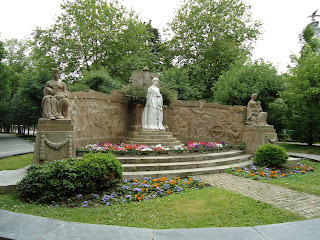Here are some of the things I saw on a daily basis and to which I´ve grown very happily accustomed.
 The railing along the long promenade above the beach is unique to the city in its shape and ornament and there are souvenir bookends and little pencil sharpeners for sale mounted by plastic replicas of its peculiar "o" shaped ballustrading.
The railing along the long promenade above the beach is unique to the city in its shape and ornament and there are souvenir bookends and little pencil sharpeners for sale mounted by plastic replicas of its peculiar "o" shaped ballustrading. Leaving Nº 26 Boulevard every day and turning into the alde zaharrean (Parte Vieja or Old Part), this is what I typically ran into. Small, ancient streets filled with restaurants, bars, purveyors of food and luxury items and, of course, tourists.
Leaving Nº 26 Boulevard every day and turning into the alde zaharrean (Parte Vieja or Old Part), this is what I typically ran into. Small, ancient streets filled with restaurants, bars, purveyors of food and luxury items and, of course, tourists. A beautiful old house.
A beautiful old house. A beautiful apartment building.
A beautiful apartment building. Everything is benevolently dominated by the Sagrado Corazon atop Mount Urgull.
Everything is benevolently dominated by the Sagrado Corazon atop Mount Urgull. Antique monuments dedicated to great Basque mariners, usually accompanied by a prayer asking Mary to intercede on behalf of the town´s sailors and spare them for their waiting families as they searched every farther and ever longer in the ocean for cod and whale.
Antique monuments dedicated to great Basque mariners, usually accompanied by a prayer asking Mary to intercede on behalf of the town´s sailors and spare them for their waiting families as they searched every farther and ever longer in the ocean for cod and whale. More recently, for many decades, Donostia hosted the royal family every summer. Where they went, so went Spain´s wealthy, powerful and famous. San Sebastián is no longer host to Europe´s crème de la crème but their traces can be found in the elegance of the boulevards, the names of the most pretigious buildings and in the grandiose villas built on the best promontories of the city. Above is Miramar, an English tudor palace built by the regent Queen Maria-Cristina.
More recently, for many decades, Donostia hosted the royal family every summer. Where they went, so went Spain´s wealthy, powerful and famous. San Sebastián is no longer host to Europe´s crème de la crème but their traces can be found in the elegance of the boulevards, the names of the most pretigious buildings and in the grandiose villas built on the best promontories of the city. Above is Miramar, an English tudor palace built by the regent Queen Maria-Cristina. With la reina Maria-Cristina came great prosperity and the township expressed its gratitude in monuments throughout the city. The statue above was erected in 1929, the year of her death.
With la reina Maria-Cristina came great prosperity and the township expressed its gratitude in monuments throughout the city. The statue above was erected in 1929, the year of her death. Another monument to the regent who saw the nation through one of its darkest years, 1898, the year Spain lost the Spanish-American War and the last of her colonies in the Philippines, Cuba and Puerto Rico. From that point on, the Spanish have been trying to decide who they are if not a great empire. It´s a process that is still evolving as not only the Basque Country but Catalonia and Galicia make ever stronger demands for ever greater independence.
Another monument to the regent who saw the nation through one of its darkest years, 1898, the year Spain lost the Spanish-American War and the last of her colonies in the Philippines, Cuba and Puerto Rico. From that point on, the Spanish have been trying to decide who they are if not a great empire. It´s a process that is still evolving as not only the Basque Country but Catalonia and Galicia make ever stronger demands for ever greater independence.


No comments:
Post a Comment